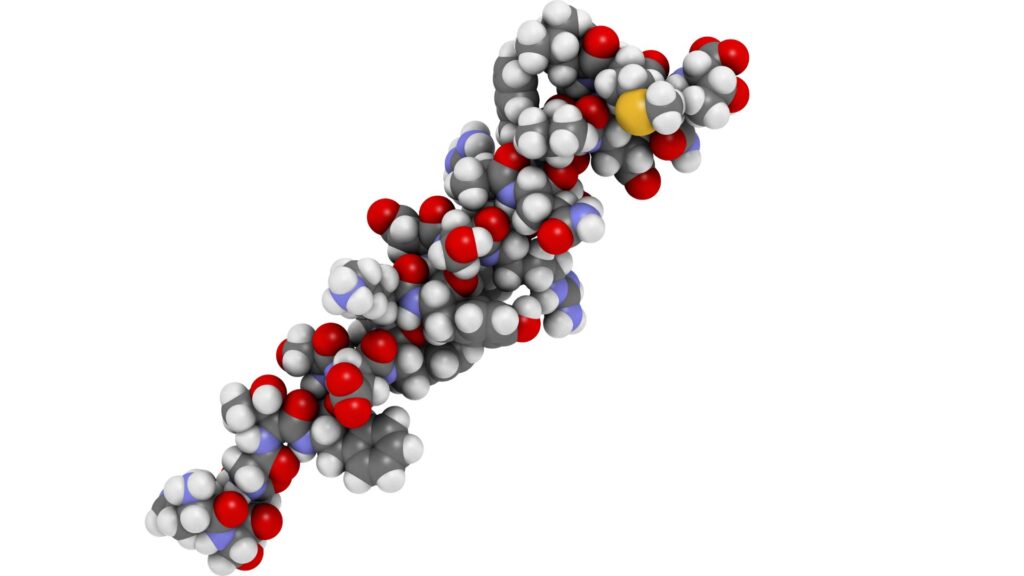|
Getting your Trinity Audio player ready...
|
Peptide therapy is emerging as a promising approach for managing chronic illnesses, offering a potential pathway to better health for those affected by long-term conditions. This therapeutic strategy harnesses the power of peptides to modulate biological functions and combat various diseases.
With the potential to address pain, inflammation, metabolic imbalances, and more, peptide therapy is gaining attention in the medical community for its versatility and targeted action.
Understanding Peptide Therapy
What are Peptides and How Do They Work?
Peptides are small chains of amino acids, the building blocks of proteins, which are essential for numerous bodily functions. They bind to receptors on the surface of cells, initiating specific responses that can lead to changes in how cells function.
From regulating hormones to influencing the immune system, peptides have a wide range of capabilities. Their ability to be synthesized to mimic natural processes in the body allows them to integrate seamlessly into our biological systems, providing targeted treatment options with minimal side effects.
Types of Peptides Used in Therapy
Peptides come in various forms, each with specific properties and functions. Bioactive peptides, for instance, have a role in regulating the immune system and reducing inflammation. These include peptides like KPV, which has been found in analysis to have anti-inflammatory and immune-modulating effects.
Other peptides like amlexanox are used for their ability to disrupt inflammatory pathways and improve metabolic functions, which can be particularly beneficial for those with metabolic disorders. Each type of peptide has a unique sequence that determines its function, allowing for precise modulation of biological processes.
The diversity of peptides available for therapy means that treatment can be tailored to the needs of each individual, addressing a variety of chronic conditions with specificity and efficacy.
Mechanism of Action in Peptide Therapy
Peptide therapy operates on the principle of signaling and regulation, initiating a cascade of biological responses through mimicking or influencing the natural peptides in the body. For instance, they can act as agonists, triggering a receptor to activate a response; or as antagonists, blocking a receptor and preventing a response. This precision allows for the modulation of the immune system, influencing inflammatory processes and even altering pain perception.
Further, studies indicate that peptides can impact the healing cycle by promoting tissue repair and regulating cytokines—molecules that signal the immune system to respond to infections and other issues. Peptide therapy fine-tunes the release and activity of cytokines, thereby helping control inflammation, which is at the heart of many chronic conditions.

Applications of Peptide Therapy in Chronic Illness
Managing Pain and Inflammation
Chronic pain and inflammation are common threads that run through many chronic illnesses, from arthritis to fibromyalgia. Peptide therapy has shown promise in managing these symptoms by targeting the inflammatory pathways and immune responses that contribute to pain.
In specific, peptides such as BPC-157 have demonstrated the ability to enhance tissue repair and promote healing, potentially reducing the discomfort associated with chronic inflammatory conditions. As research suggests:
“BPC-157 was concluded to be the most potent angiomodulatory agent, acting through different vasoactive pathways and systems (e.g. NO, VEGF, FAK) and leading to optimization of the vascular response followed, as it has to be expected, by optimization of the healing process.”
Additionally, peptides can help in detoxifying the body from toxins that exacerbate inflammation, further aiding in pain relief. With their anti-inflammatory properties, peptides can be a valuable addition to traditional treatment plans, offering a potential reduction in reliance on pain medications and their associated side effects.
Addressing Metabolic and Neurodegenerative Disorders
Metabolic disorders, such as diabetes and obesity, as well as neurodegenerative diseases like Alzheimer’s and Parkinson’s, can be particularly challenging to manage with traditional therapies alone. Peptide therapy offers a new dimension of treatment by targeting the underlying cellular processes that contribute to these conditions.
Peptides like amlexanox have been shown to improve metabolic function by modulating inflammatory responses and improving insulin sensitivity. This can lead to better control of blood sugar levels and a reduction in the symptoms associated with metabolic disorders.
Other innovative peptides, as proven in experimental investigations, have the potential to protect neurons and promote nerve growth. Relevant research further implies their effect on improving cognitive function. This is achieved by enhancing mitochondrial function, the powerhouses of the cells; and by providing neuroprotective effects, which can be particularly beneficial in slowing the progression of neurodegenerative diseases.
Modulating Immunity and Treating Autoimmune Diseases
Autoimmune diseases are characterized by immune dysregulation, where the body’s immune system mistakenly attacks its own tissues. Peptide therapy can be crucial to modulating the immune response, bringing balance back to the immune system and alleviating symptoms of autoimmune disorders.
Certain peptides have the ability to influence the behavior of immune cells. For example, polycationic peptides are indicated by established research to have an impact on reducing mast cell activation, which is implicated in many inflammatory and allergic conditions. Through controlling the release of cytokines and other inflammatory molecules, peptides can help reduce the overactive immune response that drives autoimmune disease.
Important Considerations in Peptide Therapy
While peptide therapy presents many promising avenues for the treatment of chronic illnesses, it is essential to approach this therapy with careful consideration. Peptides may interact with other medications or underlying health conditions, causing severe side effects.
The quality and source of peptides used in therapy should also be attached to great importance. Only peptides that have been properly synthesized and tested for purity and efficacy should be used in a clinical setting to ensure safety and effectiveness.
As with any treatment, peptide therapy must be tailored to the individual’s specific needs and medical history. A healthcare professional should always be consulted before beginning any new therapy.

Enhancing Treatment Outcomes with Targeted Peptide Therapy Plans
Peptide Therapy for Tissue Repair and Anti-Aging
The regenerative properties of peptides have made them a topic of interest in the field of tissue repair and anti-aging. Peptides like BPC-157 are known for their healing properties, stimulating the production of collagen and other structural proteins, promoting the repair of damaged tissues.
In addition to their regenerative capabilities, research shows that certain peptides like glutathione and carnosine, can also act as antioxidants, protecting cells from damage caused by free radicals. This antioxidant action contributes to the anti-aging effects of peptides, helping to maintain cellular health and vitality.
Combining Peptides with Other Treatments
Peptide therapy is not a standalone solution but rather a component of a multifaceted approach to healthcare. When combined with other treatments, such as lifestyle modifications, dietary changes, and traditional medications, peptides can enhance overall treatment effectiveness.
For example, in the management of chronic inflammatory conditions, peptides may be used in conjunction with other anti-inflammatory treatments to provide a synergistic effect, potentially reducing the dosage and side effects of traditional medications.
Similarly, in the context of neurodegenerative diseases, peptides may complement neuroprotective strategies, contributing to a more robust defense against the progression of such conditions.
Real-world Outcomes of Peptide Therapy
Preliminary research has shown positive results with peptide therapy in the management of various chronic conditions. Patients also reported improvements in mobility and overall quality of life.
For instance, a recent study indicated peptide-based NTS2-selective ligands are a robust alternative for future pain management, currently in high demand as an effective and safe alternative to the traditional opioid therapy.
However, it is crucial to approach these outcomes with a scientific perspective, understanding that more extensive clinical trials and research are needed to substantiate these findings.
Summary
Peptide therapy represents a burgeoning field within healthcare, offering a new horizon for individuals dealing with chronic illnesses. It is a gateway to a future where personalized and precise treatments could become the norm in managing and potentially overcoming chronic illness.
This therapy provides a targeted approach to managing pain, inflammation, immune dysregulation, and tissue repair. While the potential benefits are significant, it is essential to approach peptide therapy with informed caution, ensuring it is administered under the guidance of a healthcare professional and integrated into a broader treatment strategy.

Disclaimer: Please note that many peptide therapies are not FDA-approved and their efficacy and safety have not been fully established. It is crucial to consult with your healthcare provider before starting any new supplements or treatments, including peptide therapy.
References
Akbarian, Mohsen, Ali Khani, Sara Eghbalpour, and Vladimir N. Uversky. “Bioactive peptides: Synthesis, sources, applications, and proposed mechanisms of action.” International journal of molecular sciences 23, no. 3 (2022): 1445.
Autio, Juho, Ville Stenbäck, Dominique D. Gagnon, Juhani Leppäluoto, and Karl-Heinz Herzig. “(Neuro) peptides, physical activity, and cognition.” Journal of clinical medicine 9, no. 8 (2020): 2592.
Cicero, Arrigo FG, Federica Fogacci, and Alessandro Colletti. “Potential role of bioactive peptides in prevention and treatment of chronic diseases: A narrative review.” British journal of pharmacology 174, no. 11 (2017): 1378-1394.
Davidson, Anne, and Betty Diamond. “Autoimmune diseases.” New England Journal of Medicine 345, no. 5 (2001): 340-350.
Delétage, Nathalie, Juliette Le Douce, Noëlle Callizot, Yann Godfrin, and Sighild Lemarchant. “SCO-spondin-derived peptide protects neurons from glutamate-induced excitotoxicity.” Neuroscience 463 (2021): 317-336.
Dosanjh, Amrita, and Cindy Y. Won. “Focus: Allergic Diseases and Type II Immunity: Amlexanox: A Novel Therapeutic for Atopic, Metabolic, and Inflammatory Disease.” The Yale journal of biology and medicine 93, no. 5 (2020): 759.
Fang, Xiao-Xia, Meng-Nan Zhai, Meixuan Zhu, Cheng He, Heng Wang, Juan Wang, and Zhi-Jun Zhang. “Inflammation in pathogenesis of chronic pain: Foe and friend.” Molecular Pain 19 (2023): 17448069231178176.
Hosoyama, Katsuhiro, Caitlin Lazurko, Marcelo Muñoz, Christopher D. McTiernan, and Emilio I. Alarcon. “Peptide-based functional biomaterials for soft-tissue repair.” Frontiers in bioengineering and biotechnology 7 (2019): 470528.
Kannengiesser, Klaus, Christian Maaser, Jan Heidemann, Andreas Luegering, Matthias Ross, Thomas Brzoska, Markus Bohm, Thomas A. Luger, Wolfram Domschke, and Torsten Kucharzik. “Melanocortin-derived tripeptide KPV has anti-inflammatory potential in murine models of inflammatory bowel disease.” Inflammatory bowel diseases 14, no. 3 (2008): 324-331.
Lorenz, Dorothea, Burkhard Wiesner, Josef Zipper, Anett Winkler, Eberhard Krause, Michael Beyermann, Manfred Lindau, and Michael Bienert. “Mechanism of peptide-induced mast cell degranulation: Translocation and patch-clamp studies.” The Journal of general physiology 112, no. 5 (1998): 577-591.
Previti, Santo, Michael Desgagné, Dirk Tourwé, Florine Cavelier, Philippe Sarret, and Steven Ballet. “Opening the amino acid toolbox for peptide‐based NTS2‐selective ligands as promising lead compounds for pain management.” Journal of Peptide Science 29, no. 6 (2023): e3471.
Seiwerth, Sven, Luka Brcic, Lovorka Batelja Vuletic, Danijela Kolenc, Gorana Aralica, Marija Misic, Anita Zenko, Domagoj Drmic, Rudolf Rucman, and Predrag Sikiric. “BPC 157 and blood vessels.” Current pharmaceutical design 20, no. 7 (2014): 1121-1125.
Zhao, Fanrui, Chunlei Liu, Laura Bordoni, Irene Petracci, Dan Wu, Li Fang, Ji Wang, Xiyan Wang, Rosita Gabbianelli, and Weihong Min. “Advances on the antioxidant peptides from nuts: a narrow review.” Antioxidants 11, no. 10 (2022): 2020.


